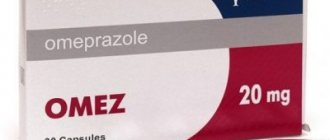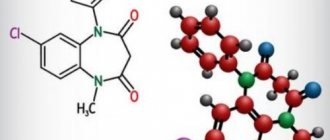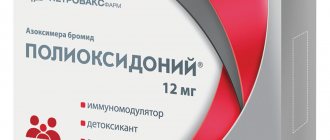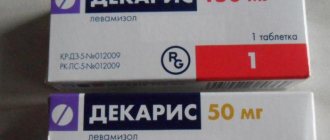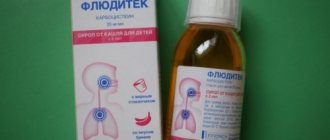Ceftriaxone has analogs for the active substance - Rocephin, Lendatsin, Azaran. The first drug is the most expensive, but it is original. It is more often prescribed to children due to its high degree of purification. If you need to replace it with tablets, then take into account that Cephalexin is weaker, Pantsef and Suprax will help with infections of the ear, throat, and urinary tract, but do not give results with pneumonia. Zinnat is safe and is indicated for mild forms of infection.
To replace Ceftriaxone in ampoules with a stronger drug, Cefotaxime and Cefepime are prescribed, and Cefazolin will have a weaker effect. Of all the cephalosporins, only Ceftriaxone is administered once a day, while the others need to be injected more often. When prescribing potent tablets, Sumamed or Mofloxia may be indicated. Suprax or Cephalexin in the form of a suspension is recommended for children.
Pharmacodynamics and pharmacokinetics
What is Ceftriaxone?
According to Wikipedia, ceftriaxone is an antibiotic whose bactericidal effect is due to its ability to disrupt the synthesis of peptidoglycan in bacterial cell walls.
Pharmacodynamics
A universal antibacterial agent, the mechanism of action of which is determined by the ability to suppress the synthesis of the bacterial cell wall. The drug exhibits greater resistance to most β-lactamases of gram(+) and gram(-) microorganisms.
Active regarding:
- Gram(+) aerobes - St. aureus (including penicillinase-producing strains) and Epidermidis, Streptococcus (pneumoniae, pyogenes, viridans group);
- Gram(-) aerobes - Enterobacter aerogenes and cloacae, Acinetobacter calcoaceticus, Haemophilus influenzae (including penicillinase-producing strains) and parainfluenzae, Borrelia burgdorferi, Klebsiella spp. (including pneumoniae), Escherichia coli, Moraxella catarrhalis and diplococci of the genus Neisseria (including penicillinase-producing strains), Morganella morganii, Proteus vulgaris and Proteus mirabilis, Neisseria meningitidis, Serratia spp., some strains of Pseudomonas aeruginosa;
- anaerobes - Clostridium spp. (exception: Clostridium difficile), Bacteroides fragilis, Peptostreptococcus spp..
In vitro (clinical significance remains unknown) activity is observed against strains of the following bacteria: Citrobacter diversus and freundii, Salmonella spp. (including against Salmonella typhi), Providencia spp. (including in relation to Providencia rettgeri), Shigella spp.; Bacteroides bivius, Streptococcus agalactiae, Bacteroides melaninogenicus.
Methicillin -resistant Staphylococcus, many strains of Enterococcus (including Str. faecalis) and group D Streptococcus are resistant to cephalosporin antibiotics (including ceftriaxone).
Pharmacokinetics
- bioavailability - 100%;
- T Cmax when Ceftriaxone is administered intravenously - at the end of the infusion, when administered intramuscularly - 2-3 hours;
- connection with plasma proteins - from 83 to 96%;
- T1/2 with intramuscular administration - from 5.8 to 8.7 hours, with intravenous administration - from 4.3 to 15.7 hours (depending on the disease, the patient’s age and the condition of his kidneys).
In adults, the concentration of ceftriaxone in the cerebrospinal fluid when administered 50 mg/kg after 2-24 hours is many times higher than the MIC (minimum inhibitory concentration) for the most common pathogens of meningococcal infection . The drug penetrates well into the cerebrospinal fluid during inflammation of the meninges.
Ceftriaxone is excreted unchanged:
- kidneys - by 33-67% (in newborn babies this figure is 70%);
- with bile into the intestines (where the drug is inactivated) - by 40-50%.
Hemodialysis is ineffective.
Cephalosporin Ceftazidime
Ceftazidime is a drug from the group of 3rd generation cephalosporins, which is considered the most effective antibacterial agent against pathogens of nosocomial pneumonia. It has such a wide spectrum of action that its use is practiced even before the results of laboratory tests are obtained. Ceftazidime is started immediately to improve the patient’s well-being, and then the therapeutic regimen is adjusted. The drug disrupts the production of membrane components, which causes an imbalance of bacterial cells.
Its undoubted advantage is its resistance to the effects of most beta-lactamases. The drug in ampoules is administered intravenously or intramuscularly in individual doses. The amount of solution and its concentration depend on the severity of pneumonia, the age of the patient and the state of kidney function. Typically, therapy is carried out as long as necessary to eliminate fever and chills. On average, Ceftazidime is used in a dose of 1-6 g per day, divided into 2 or 3 injections.
The list of contraindications for the drug only includes hypersensitivity to Ceftazidime and other cephalosporins. Its administration during pregnancy or breastfeeding is possible if safer means are ineffective. Ceftazidime is used with caution in cases of severe renal impairment.
Indications for use of Ceftriaxone
The annotation states that the indications for the use of Ceftriaxone are infections caused by bacteria sensitive to the drug. Intravenous infusions and injections of medications are prescribed to treat:
- infections of the abdominal cavity (including empyema of the gallbladder , angiocholitis , peritonitis ), ENT organs and respiratory tract ( empyema of the pleura , pneumonia , bronchitis , lung abscess , etc.), bone and joint tissue, soft tissues and skin, urogenital tract (including pyelonephritis , pyelitis , prostatitis , cystitis , epididymitis );
- epiglottitis;
- infected burns/wounds;
- infectious lesions of the maxillofacial area;
- bacterial septicemia;
- sepsis;
- bacterial endocarditis;
- bacterial meningitis;
- syphilis;
- chancroid;
- tick-borne borreliosis (Lyme disease);
- uncomplicated gonorrhea (including in cases where the disease is caused by microorganisms that secrete penicillinase);
- salmonellosis/salmonella carriage;
- typhoid fever.
The drug is also used for perioperative prophylaxis and for the treatment of immunocompromised patients.
What is Ceftriaxone used for for syphilis?
Although Penicillin is the drug of choice of syphilis , its effectiveness may be limited in some cases.
The use of cephalosporin antibiotics is resorted to as a backup option in case of intolerance to drugs of the penicillin group.
The valuable properties of the drug are:
- the presence in its composition of chemical substances that have the ability to suppress the formation of cell membranes and mucopeptide synthesis in the walls of bacterial cells;
- the ability to quickly penetrate organs, fluids and tissues of the body and, in particular, into the cerebrospinal fluid, which in patients with syphilis undergoes many specific changes;
- Possibility of use for the treatment of pregnant women.
The medicine is most effective in cases where the causative agent of the disease is Treponema pallidum, since the distinctive feature of Ceftriaxone is its high treponemocidal activity. The positive effect is especially pronounced with intramuscular administration of the drug.
Treatment of syphilis with the use of the drug gives good results not only in the early stages of the disease, but also in advanced cases: with neurosyphilis , as well as with secondary and latent syphilis.
Since T1/2 of Ceftriaxone is approximately 8 hours, the drug can be used equally successfully in both inpatient and outpatient treatment regimens. It is enough to administer the drug to the patient once a day.
For preventive treatment, the drug is administered over 5 days, for primary syphilis - a 10-day course, early latent and secondary syphilis are treated within 3 weeks.
For non-advanced forms of neurosyphilis, the patient is administered a single dose of 1-2 g of Ceftriaxone for 20 days; in the later stages of the disease, the drug is administered at a dose of 1 g/day. for 3 weeks, after which an interval of 14 days is maintained and treatment with a similar dosage is carried out for 10 days.
For acute generalized meningitis and syphilitic meningoencephalitis, the dose is increased to 5 g/day.
Ceftriaxone injections: why is the drug prescribed for angina in adults and children?
Despite the fact that the antibiotic is effective for various lesions of the nasopharynx (including sore throat and sinusitis ), it is, as a rule, rarely used as a drug of choice, especially in pediatrics.
For angina, the medicine can be administered through a dropper into a vein or in the form of regular injections into the muscle. However, in the vast majority of cases, the patient is prescribed intramuscular injections. The solution is prepared immediately before use. The finished mixture remains stable at room temperature for 6 hours after preparation.
For children with angina, Ceftriaxone is prescribed in exceptional cases when acute angina is complicated by severe suppuration and inflammation.
The appropriate dosage is determined by the attending physician.
During pregnancy, the drug is prescribed in cases where penicillin antibiotics are not effective. Although the medicine crosses the placental barrier, it does not have a significant effect on the health and development of the fetus.
Treatment of sinusitis with Ceftriaxone
For sinusitis, antibacterial agents are first-line drugs. Completely penetrating the blood, Ceftriaxone is retained at the site of inflammation in the required concentrations.
As a rule, the medicine is prescribed in combination with mucolytics , vasoconstrictors , etc.
How to inject the drug for sinusitis? Typically, the patient is prescribed Ceftriaxone to be injected into the muscle twice a day, 0.5-1 g. Before injection, the powder is mixed with Lidocaine (it is preferable to use a one percent solution) or d/i water.
Treatment lasts at least 1 week.
Solution for infusion Levofloxacin
Levofloxacin is an antibacterial agent from the fluoroquinolone group. Gram-positive enterococci, Staphylococcus aureus and epidermal staphylococci, pneumococci, streptococci, gram-negative Haemophilus influenzae, Proteus and many other pathogens have not lost sensitivity to its active substance.
Its use in the treatment of pneumonia in adults leads to blocking of DNA supercoiling processes. The cells also stop producing proteins to build their membranes, so they are destroyed under the pressure of the intercellular fluid.
Levofloxacin in combination with Ceftriaxone has recently been especially often used in the treatment of pneumonia caused by coronavirus.
The antibacterial agent is administered intravenously by drip with a constantly increasing dose - from 250 mg to 750 mg. The duration of therapy depends on the sensitivity of the causative agent of pneumonia, ranging from one to two weeks. If necessary, treatment continues with Levofloxacin in tablet form.
The drug is not prescribed to patients with hypersensitivity to quinolones, epilepsy, tendon lesions caused by taking fluoroquinolone antibiotics. Levofloxacin can only be used in the treatment of pneumonia in adults. During pregnancy and breastfeeding, the drug is used for health reasons.
Contraindications
Ceftriaxone is not prescribed in case of known hypersensitivity to cephalosporin antibiotics or auxiliary components of the drug.
Relative contraindications:
- the neonatal period if the child has hyperbilirubinemia ;
- prematurity;
- renal/liver failure;
- enteritis , UC or colitis associated with the use of antibacterial agents;
- pregnancy;
- lactation.
Carbapenem Meronem
Meronem is an antibacterial agent from the carbapenem group, used only for parenteral use. It has a pronounced bactericidal effect by blocking the synthesis of bacterial cell walls. The drug is often used in the treatment of severe pneumonia, since a wide range of aerobic and anaerobic bacteria have not lost sensitivity to it.
The difference between Ceftriaxone and Meronem is the latter's greater ability to penetrate bacterial cell walls, greater stability to beta-lactamases, and significant affinity for penicillin-binding proteins. For adults with pneumonia, the medicine is administered intravenously at 500 mg every 8 hours, after diluting it with water for injection.
| Contraindications to the treatment of pneumonia with Meronem injections | |
| Absolute | Relative |
| Hypersensitivity to any antibiotic with a beta-lactam structure, including cephalosporins and penicillins | Gastrointestinal disorders, including diarrhea |
| Hypersensitivity to Meropenem or other carbapenems | Concomitant use of potentially nephrotoxic drugs |
There are no contraindications for pregnancy and lactation. But doctors prescribe Meronem to women extremely rarely for health reasons. During lactation, it is recommended to stop breastfeeding during treatment.
Side effects of Ceftriaxone
Side effects of the drug appear as:
- hypersensitivity reactions: eosinophilia , fever, itching, urticaria edema , skin rash, multiforme (in some cases malignant) exudative erythema , serum sickness , anaphylactic shock , chills;
- headache and dizziness;
- oliguria;
- dysfunction of the digestive organs: nausea, vomiting, flatulence , taste disturbance, stomatitis , diarrhea , glossitis , formation of sludge in the gallbladder and pseudocholelithiasis , pseudomembranous enterocolitis , dysbacteriosis , candidomycosis and other superinfections;
- hematopoiesis disorders: anemia (including hemolytic ), lymphopenia , leukopenia, neutropenia, thrombocytopenia, granulocytopenia , thrombocytosis and leukocytosis , hematuria , basophilia , nosebleeds).
If the medicine is administered intravenously, inflammation of the venous wall, as well as pain along the vein, is possible. The injection of the drug into the muscle is accompanied by pain at the injection site.
Ceftriaxone (injections and IV infusion) may also affect laboratory parameters. The patient's prothrombin time decreases (or increases), the activity of alkaline phosphatase and liver transaminases increases, as well as the concentration of urea, hypercreatininemia , hyperbilirubinemia , and glycosuria .
Reviews of the side effects of Ceftriaxone allow us to conclude that with intramuscular administration of the drug, almost 100% of patients complain of severe pain from the injection, some report muscle pain, dizziness, chills, weakness, itching and rash.
The injections are easiest to tolerate if you dilute the powder with an anesthetic. In this case, it is necessary to do a test both for the drug itself and for the painkiller.
Instructions for use of Ceftriaxone (Method and dosage)
How to dilute Ceftriaxone for injection?
The manufacturer's instructions, as well as the Vidal reference book, indicate that the drug can be injected into a vein or into a muscle.
Dosage for adults and children over 12 years of age: 1-2 g/day. The antibiotic is administered once or once every 12 hours at half the dose.
In particularly serious cases, as well as if the infection is caused by a pathogen moderately sensitive to Ceftriaxone, the dose is increased to 4 g/day.
For gonorrhea , a single injection of 250 mg of the drug into the muscle is recommended.
For preventive purposes, before an infected or suspected infected operation, depending on the degree of danger of infectious complications, the patient should be administered a single dose of 1-2 g of Ceftriaxone 0.5-1.5 hours before surgery.
For children in the first 2 weeks of life, the medicine is administered 1 time per day. The dose is calculated using the formula 20-50 mg/kg/day. The highest dose is 50 mg/kg (which is due to the underdevelopment of the enzyme system).
The optimal dosage for children under 12 years of age (including infants) is also selected depending on weight. The daily dose varies from 20 to 75 mg/kg. For children weighing more than 50 kg, Ceftriaxone is prescribed in the same dose as for adults.
Doses greater than 50 mg/kg should be administered as an intravenous infusion over at least 30 minutes.
For bacterial meningitis, treatment begins with a single dose of 100 mg/kg/day. The highest dose is 4 g. As soon as the pathogen is isolated and its sensitivity to the drug is determined, the dose is reduced.
Reviews about the drug (in particular, about its use in children) allow us to conclude that the drug is very effective and affordable, but its significant drawback is severe pain at the injection site. As for side effects, according to the patients themselves, there are no more of them than with any other antibiotic.
How many days to inject the drug?
The duration of treatment depends on what pathogenic microflora causes the disease, as well as on the characteristics of the clinical picture. If the causative agent is Gram (-) diplococci of the genus Neisseria, the best results can be achieved in 4 days, if enterobacteria are sensitive to the drug - in 10-14 days.
Ceftriaxone injections, instructions for use. How to dilute the drug?
Lidocaine solution (1 or 2%) or water for injection (d/i).
When using water d/i, it should be taken into account that intramuscular injections of the drug are very painful, so if the solvent is water, there will be discomfort both during the injection and for some time after it.
Water for diluting the powder is usually taken in cases where the use of Lidocaine is impossible due to the patient being allergic to it.
The best option is a one percent solution of Lidocaine. It is better to use water as an adjuvant when diluting the drug with Lidocaine 2%.
Is it possible to dilute Novocaine with Ceftriaxone?
Novocaine , when used to dilute the drug, reduces the activity of the antibiotic, while at the same time increasing the likelihood of the patient developing anaphylactic shock .
Based on the reviews of the patients themselves, they note that Lidocaine is better than Novocaine in relieving pain when Ceftriaxone is administered.
In addition, the use of a non-freshly prepared solution of Ceftriaxone with Novocaine increases pain during injection (the solution remains stable for 6 hours after preparation).
How to dilute Ceftriaxone with Novocaine?
If Novocain is used as a solvent, it is taken in a volume of 5 ml per 1 g of the drug. If you take a smaller amount of Novocaine, the powder may not completely dissolve, and the syringe needle will become clogged with lumps of medicine.
Dilution with Lidocaine 1%
For injection into the muscle, 0.5 g of the drug is dissolved in 2 ml of a one percent solution of Lidocaine (the contents of one ampoule); For 1 g of the drug take 3.6 ml of solvent.
The dosage of 0.25 g is diluted in the same way as 0.5 g, that is, with the contents of 1 ampoule of 1% Lidocaine. After this, the finished solution is drawn into different syringes, half the volume in each.
The medicine is injected deep into the gluteal muscle (no more than 1 g in each buttock).
The drug diluted with Lidocaine is not intended for intravenous administration. It is allowed to be injected strictly into the muscle.
How to dilute Ceftriaxone injections with Lidocaine 2%?
To dilute 1 g of the drug, take 1.8 ml of water and two percent Lidocaine. To dilute 0.5 g of the drug, also mix 1.8 ml of Lidocaine with 1.8 ml of water, but only half of the resulting solution (1.8 ml) is used for dissolution. To dilute 0.25 g of the drug, take 0.9 ml of a solvent prepared in a similar way.
How to dilute Ceftriaxone for intramuscular administration in children?
This method of intramuscular injection is practically not used in pediatric practice, since Ceftriaxone with Novocaine can cause severe anaphylactic shock in a child, and in combination with Lidocaine, it can contribute to the occurrence of convulsions and disruption of the heart.
For this reason, the optimal solvent when using the drug in children is ordinary water. The impossibility of using painkillers in childhood requires an even slower and more careful administration of the medicine in order to reduce pain during the injection.
Dilution for intravenous administration
For intravenous administration, 1 g of the drug is dissolved in 10 ml of distilled water (sterile). The drug is administered slowly over 2-4 minutes.
Dilution for intravenous infusion
When carrying out infusion therapy, the drug is administered for at least half an hour. To prepare a solution, 2 g of powder is diluted in 40 ml of a Ca-free solution: dextrose (5 or 10%), NaCl (0.9%), fructose (5%).
Additionally
Ceftriaxone is intended exclusively for parenteral administration: manufacturers do not produce tablets and suspensions due to the fact that the antibiotic, when in contact with body tissues, is highly active and severely irritates them.
Doses for animals
The dosage for cats and dogs is selected taking into account the body weight of the animal. As a rule, it is 30-50 mg/kg.
If a 0.5 g bottle is used, 1 ml of two percent Lidocaine and 1 ml of water d/i (or 2 ml of Lidocaine 1%) should be added to it. After vigorously shaking the medicine until the lumps are completely dissolved, it is drawn into a syringe and injected into the muscle or under the skin of the sick animal.
The dosage for a cat (Ceftriaxone 0.5 g is usually used for small animals - cats, kittens, etc.), if the doctor prescribed 40 mg of Ceftriaxone per 1 kg of weight, is 0.16 ml/kg.
For dogs (and other large animals), take bottles of 1 g. The solvent is taken in a volume of 4 ml (2 ml Lidocaine 2% + 2 ml water for injection). For a dog weighing 10 kg, if the dose is 40 mg/kg, you need to administer 1.6 ml of the prepared solution.
If it is necessary to administer Ceftriaxone intravenously through a catheter, sterile distilled water is used for dilution.
Rocephin for injection
Rocephin is a structural analogue of Ceftriaxone, which is produced by a Swiss pharmaceutical company. It has identical active substance, indications and contraindications for use. It costs 3-4 times more than the domestic product, but this does not affect its effectiveness. Like Ceftriaxone, Rocephin is intended for parenteral use.
The antibiotic has a long-lasting effect, and its bactericidal activity is based on the suppression of the biosynthesis of cell membranes and RNA replication. Adults are prescribed 1-2 g of the drug once a day. Depending on the clinical situation, the daily dose is increased to 4 g. Before intramuscular injection, the powder is diluted in Lidocaine for local anesthesia. In other cases, sterile water or isotonic sodium chloride solution is used.
The duration of the therapeutic course is individual, but usually for pneumonia, Rocephin is administered for another 2-3 days after the temperature normalizes. The list of contraindications for the antibacterial agent includes hypersensitivity to cephalosporin drugs and auxiliary ingredients. It is necessary to inject it with caution if you are individually intolerant to any penicillins. This is also true during pregnancy and breastfeeding.
Interaction
In one volume, it is pharmaceutically incompatible with other antimicrobial agents.
By suppressing intestinal microflora, it prevents the formation of vitamin K . For this reason, the use of the drug in combination with drugs that reduce platelet aggregation (sulfinpyrazone, NSAIDs) may provoke bleeding.
The same feature of Ceftriaxone enhances the effect of anticoagulants when used together.
In combination with loop diuretics, the risk of nephrotoxicity increases.
special instructions
The drug is used in a hospital setting. In patients who are on hemodialysis, as well as with simultaneous severe hepatic and renal failure, plasma concentrations of Ceftriaxone should be kept under control.
With long-term treatment, regular monitoring of the peripheral blood picture and indicators characterizing the function of the kidneys and liver is required.
Sometimes (rarely) an ultrasound of the gallbladder may show shadows that indicate the presence of sediment. The darkening disappears after stopping the course of treatment.
vitamin K in addition to Ceftriaxone .
If there is an imbalance of water and electrolytes, as well as arterial hypertension , the level of sodium in the blood plasma should be monitored. If the treatment is long-term, the patient is advised to undergo a general blood test.
Like other cephalosporins, the drug has the ability to displace bilirubin , and therefore it is used with caution in newborns with hyperbilirubinemia (and, in particular, in premature infants).
The drug does not affect the speed of neuromuscular conduction.
A little about generics
Generic Ceftriaxone differs from the original Rocephin in that they do not have sufficient clinical studies. Often, the manufacturer copies the antibiotic molecule, but the technology and degree of purification are not the same. Therefore, in severe cases of the disease, the introduction of the original is recommended.
A more expensive but reliable option is chosen for children, especially infants, patients with drug allergies, and kidney and liver diseases. If financially possible, you should always buy the original drug.
Ceftriaxone analogues, what can replace the drug?
Level 4 ATC code matches:
Cephosin
Lendatsin
Medakson
Loprax
Cefixime
Lorakson
Sulperazon
Cefoperazone
Rocephin
Tsedex
Fortum
Ceftazidime
Cefotaxime
Cefix
Ceforal Solutab
Pantsef
Claforan
Cefodox
Suprax Solutab
Analogues of Ceftriaxone in injections:
- Ceftriaxone-LEKSVM (Kabi, Jodas, KMP, Promed, Vial, Elfa)
- Ceftriabol
- Tsefson
- Cefaxon
- Torotsef
- Hizon
- Cephogram
- Medakson
- Lorakson
- Ifitsef
Analogues in tablets:
- Pantsef
- Suprax Solutab
- Ceforal Solutab
- Cefpotec
- Spectraceph
Ceftriaxone or Cefazolin - which is better?
Both drugs belong to the cephalosporin group, but Ceftriaxone is a third-generation antibiotic, and Cefazolin is a first-generation drug.
An important feature of first generation cephalosporin antibiotics is that they are not effective against listeria and enterococci, have a narrow spectrum of action and a low level of activity against gram(-) bacteria.
Cefazolin is used mainly in surgery for perioperative prophylaxis, as well as for the treatment of soft tissue and skin infections.
Its prescription for the treatment of infections of the genitourinary system and respiratory tract cannot be considered as justified, which is associated with a narrow spectrum of antimicrobial activity and high resistance to it among potential pathogens.
Which is better: Ceftriaxone or Cefotaxime?
Cefotaxime and Ceftriaxone are the basic antimicrobial agents of the third generation cephalosporin group. The drugs are almost identical in their bactericidal properties.
Semi-synthetic antibiotic Amikacin
Amikacin is a representative of the group of aminoglycosides - organic compounds that are united by the presence in their chemical structures of amino sugars connected by glycosidic bonds to aminocyclic rings. This analogue of Ceftriaxone in ampoules for adults.
Unlike Ceftriaxone, staphylococci, which often act as infectious agents of pneumonia, are slightly more sensitive to Amikacin.
Its active substance interferes with the biosynthesis of RNA in bacteria, which causes their death. Many pathogenic microorganisms have not developed resistance to the effects of the drug.
However, as with Ceftriaxone. Therefore, the answer to the question of which is better - Amikacin or Ceftriaxone - is obvious - the effectiveness of the drugs for pneumonia is approximately the same. The antibiotic is intended for intramuscular and intravenous administration. The maximum daily dose for adults is 15 mg/kg. The solution is prepared immediately before use by mixing the contents of the bottle with the following solvents:
- water for injections;
- 0.9% sodium chloride solution;
- 5% dextrose solution.
The duration of the therapeutic course for intravenous administration varies from 3 to 7 days, for intramuscular administration - from 7 to 10 days. Amikacin is contraindicated during pregnancy, acoustic neuritis, and severe kidney disease.
Ceftriaxone during pregnancy and breastfeeding
The drug is contraindicated in the first trimester of pregnancy. If it is necessary to prescribe to a nursing woman, the child should be switched to formula.
Reviews of Ceftriaxone during pregnancy confirm that the drug is indeed a very powerful and very effective antibacterial agent that can not only cure the underlying disease, but also prevent the development of its complications.
Considering that the drug (like other antibiotics) has side effects, it is prescribed only in cases where potential complications of the disease could be more harmful than the use of the drug (in particular, for infections of the urogenital tract, to which pregnant women are very susceptible).
Cephalosporin antibiotics
Cephalosporins are a group of antibacterial agents that are widely in demand in the treatment of infectious lesions of the respiratory system, including pneumonia. They are used for inpatient and outpatient treatment, are well tolerated by patients, have low toxicity, and rarely provoke the development of adverse reactions. In pharmacology, cephalosporin antibiotics are classified as follows:
- first generation
- Cefazolin, Cephalexin, Cefadroxil; - second generation
— Cefuroxime, Cefaclor, Cefamandole; - third generation
- Cefotaxime, Cefoperazone, Ceftriaxone, Ceftibuten, Ceftazidime; - fourth generation
- Cefpirom, Cefepim; - fifth generation
- Ceftobiprole, Ceftaroline.
In the treatment of bacterial or mixed pneumonia, antibacterial drugs of the second and third generations, including Ceftriaxone, have proven well.
Its closest analogues are representatives of the cephalosporin group. But there are other antibacterial agents for adults that are similar in effectiveness, safety, list of indications and method of use with Ceftriaxone.
Reviews of Ceftriaxone
Ceftriaxone is a potent antibiotic (reviews from doctors confirm this fact), which helps cure the disease in a short time and with a minimum number of side effects. It is allowed to be used for children and during pregnancy (exception - 1st trimester).
According to the patients themselves, the main disadvantage of the drug is that the injections are very painful.
In reviews of Ceftriaxone injections for children, to facilitate the procedure, mothers (on the advice of the attending physician) are recommended to use Emla , which is a local anesthetic. It is applied in about half an hour to the intended injection site.
Expensive substitutes
The list of good, but high-cost products includes Azaran and Rocephin. The drugs are recommended for the treatment of minors due to rare cases of side effects, manifested by:
- breathing problems, cough;
- obsessive itching, dermatological rash, red spots;
- nettle fever, serum sickness, anaphylaxis.
During therapy there are no unpleasant sensations in the gastrointestinal tract or changes in the composition of the blood.
Ceftriaxone price, where to buy
How much does an antibiotic cost in Russian pharmacies? The price of Ceftriaxone injections varies depending on which company produces it, as well as the number of ampoules in each package and the concentration of the active substance in the vial.
The price of Ceftriaxone in Russian pharmacies is from 30 rubles per bottle.
The price of Ceftriaxone in Ukraine is from 15 UAH. per bottle of 1 g. At the same time, there is no significant difference between prices in the capital's pharmacies and pharmacies in other cities (Kharkov, Dnepropetrovsk, Lvov).
It is impossible to buy Ceftriaxone tablets. The drug is intended exclusively for parenteral administration.
- Online pharmacies in RussiaRussia
- Online pharmacies in UkraineUkraine
- Online pharmacies in KazakhstanKazakhstan
ZdravCity
- Ceftriaxone por.
ready sol. intravenous and intramuscular injection. fl. 1 g 50 pcs. PJSC Kraspharma 1179 rub. order - Ceftriaxone powder for injection solution 1g bottle JSC Pharmaceutical company LEKKO
42 RUR order
- Ceftriaxone powder for injection solution for IV and IM injection. 1gJSC "Rapharma"
45 rub. order
- Ceftriaxone powder prig solution for intravenous and intramuscular administration. 1gPAO Biosintez
46 RUR order
- Ceftriaxone por. d/prig solution for IV and IM insertion. fl. 1g (individual pack)Deco Company LLC
40 rub. order
Pharmacy Dialogue
- Ceftriaxone (vial 1g IM, IV) Belmedpreparaty
52 RUR order
- Ceftriaxone (vial 1g intravenous i.m. individual pack) Lecco JSC
43 RUR order
- Ceftriaxone (vial 1g i.v. i.m. individual pack) Ruzpharma LLC
36 RUR order
- Ceftriaxone (vial 1g i.m., i.v.) Biosynthesis OJSC
RUB 882 order
- Ceftriaxone 1g IV IM ind. upbzmp
41 rub. order
show more
Pharmacy24
- Ceftriaxone 1 g N10 powder PAT "Kievmedpreparat", Ukraine
151 UAH.order - Ceftriaxone-BHFZ 500 mg No. 1 powder PAT NVC "Borshchagivsky chemical-pharmaceutical plant", Kiev, Ukraine
11 UAH order
- Ceftriaxone-Darnitsa 0.5 g N5 lyophilisate for the preparation of solution for injection PrAT" Pharmaceutical company "Darnitsa", Ukraine
58 UAH order
- Ceftriaxone-Darnitsa 1 g No. 5 solution PrAT” Pharmaceutical company “Darnitsa”, Ukraine
72 UAH order
- Ceftriaxone 1.0 g No. 1 powder AT Lekhim-Kharkiv, Ukraine
13 UAH order
PaniPharmacy
- Ceftriaxone bottle Ceftriaxone sodium salt powder for injection 1g Ukraine, Kievmedpreparat OJSC
169 UAH order
- CEFTRIAXONE bottle Ceftriaxone powder for injection 1g No. 5 Ukraine, Lekhim-Kharkov JSC
74 UAH order
- Ceftriaxone bottle Ceftriaxone sodium salt powder for injection 0.5g Ukraine, Kievmedpreparat OJSC
110 UAH order
- Ceftriaxone bottle Ceftriaxone powder for injection 1g bottles No. 40 Ukraine, Darnitsa ChAO
681 UAH order
- CEFTRIAXONE bottle Ceftriaxone powder for injection 1g Ukraine, Lekhim-Kharkov JSC
15 UAH order
show more
